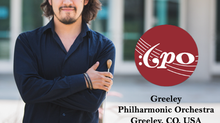Opera in a New Era: Barber of Seville by IU 2020 - A Production Chronicle by Diego Barbosa-Vásquez
- Diego Barbosa-Vásquez
- Nov 19, 2020
- 11 min read
Updated: Nov 25, 2020

Kevin Murphy – Conductor
Michael Shell – Director
Trevor Regars - Stage Manager
Diego Barbosa-Vásquez - Assistant/Cover Conductor
*Para versión en Español: Da Click Aquí
Doing Opera in the middle of a pandemic is a huge fortune. While many theaters and opera companies worldwide were obliged to stop their performing activities, Indiana University Opera and Ballet worked very hard to produce an opera following the health measures in the middle of a pandemic. This text is the story of how an opera with more than two hundred years of tradition was rethought and produced during a difficult time following all the safety procedures. This is the story of an opera that was broadcasted to the whole world by IU Music Life on Nov 13th and 14th of 2020. This is a story of how arts help us overcome difficult situations showing that making beauty is still possible.

As one of the most performed Operas worldwide, Indiana University Opera and Ballet department selected an opera that all singers have to have in their repertoire. Rossini's Il Barbiere di Siviglia. Known as a high-level Music School, in terms of Opera, Indiana University focuses on offer to singers, conductors, pianists, orchestra musicians, and full Opera related field experiences as close to the real performing professional life worldwide. This university prepares the leading musicians of tomorrow. In this specific production, Il Barbiere di Siviglia, Nov 2020, in the middle of a Pandemic, they really prepared musicians to be creative to overcome problems doing great art no matter the difficulties.
This Opera experience came to me in the middle of April 2020. I was informed by my current Conducting Maestro Arthur Fagen, that I would be appointed as Assistant/Cover Conductor of Indiana University Opera starting in August 2020. The original plan of Il Barbiere di Siviglia was to be produced in the standard way with premiere in October and 4 performances. Six weeks of preparation of singers between musical, stage, and last rehearsals. In terms of the orchestra, around two weeks of rehearsals for the players alone and with the singers. And the production was meant to be conducted by Maestro Marzio Conti, a worldwide renowned Italian conductor with huge experience in Ballet, Italian Opera, and the symphonic recording industry.

Photo: Working with Maestro Conti and the IU Conductors Orchestra on the difficult Stravinsky's Ballet "Petrushka".
I assisted Maestro Conti previously and I knew how demanding he his in every single detail, with a rehearsal technique very similar to mine. Therefore in the case of this opera my role, was to assist and cover the conductor in whatever was necessary (usually conduct orchestra and singers as required and be the right hand of Maestro giving constantly notes to singers and orchestra). Therefore my preparation started in May to have the Opera ready to conduct and rehearse the first rehearsals as is usually done if the Maestro arrived late.
However, after the first weeks of the COVID-19 problem passed without a clear solution, the situation started to change. Now in the mind of all was, could we produce Opera in Fall 2020 when all the world is still trying to figure out how to live? I have to imagine that the summer days were a very difficult moment for the IU Opera Administrators, trying to arrive at a solution that could offer a viable opera in the middle of a pandemic. By this time, I only focused on learning the music in great detail to perform my role as an assistant conductor properly.
By the beginning of Fall 2020, the news arrived. Il Barbiere di Siviglia was moved to October-November instead of August-September. The Italian Maestro Marzio Conti could not come due to the travel restrictions to visitors that Indiana University created to protect the students, staff, and faculty. No one outside IU circle could come to the camps. Thankfully, IU Jacobs School of Music has an upstanding faculty with tons of experiences, and immediately the solution was available. The conductor will be either Maestro Arthur Fagen, the Chair of Opera and Orchestra Conducting Department of Jacobs School of Music at Indiana University. Who is my main professor in the Doctor Degree in Conducting at IU. He is current Music Director of Atlanta Opera and with opera conducting experiences at the world’s most prestigious opera houses including the Metropolitan Opera at the US and Vienna State Opera in Austria.

Photo: Learning all the traditions, stylistic approaches and conducting secret tips of Barber of Seville with Maestro Fagen... Yes, by Zoom!
Or Maestro Kevin Murphy, current professor of music in collaborative piano and director of coaching and music administration for IU Opera Theater at the Indiana University Jacobs School of Music. Current Artistic Director of Summer Opera Tel Aviv, Singers Director at Ravinia Festival and former Assistant Conductor of James Lavine at The Metropolitan Opera, and former Director of Musical Studies at Paris National Opera.

Photo with Maestro Murphy after the last show. Great experience, even at 10 feet apart we did it!
At the end, I had the pleasure of studying and assisting the Opera with both maestros. Both worked together and coached the singers in this production. Maestro Fagen from video call and Maestro Murphy as the Main conductor on stage.
But the safety question was still unresolved: How to produce an opera that could be done with the safety procedures? In first place, after the researches about aerosols, the policy states that The Musical Arts Center, the house of the Opera at Indiana University, will allow only up to 31 people on stage and pit, including the orchestra. All to provide at least 9.2 M2 (100 ft2) between players and stay safe.
Normally the traditions of this Opera encourage the use of around 80 to 90 people involved. This number includes a full orchestra of 40-50 musicians. Around 8 first violins, 6-8 second violins, 4-6 violas, 4-6 cellos, 3-4 basses, 2 flutes, 2 oboes, 2 clarinets, 2 horns, 2 trumpets, 3 trombons and 2 percussion players. 30 singers: Around 22 choir singers (tenors and basses) and 7 principal characters: Conte Almaviva, Rosina, Figaro, Bartolo, Don Basilio, Berta, Fiorello. And the full production staff. Obviously this numbers in the middle of a pandemic were not possible.

Provide at least 9.2 M2 (100 ft2) between players and stay safe was translated in an impossibility to do the Opera with a full orchestra. The solution was clever and only possible by the level of collaborative piano department students at IU. The full orchestra was be done with a piano[1]. The pianist had to play not only for rehearsals as is usually done to help the singers in their preparation but also for the Opera show in itself. Marika Yasuda and Lucas Nogara were the pianists, switching between orchestra's roles and clave for the recitatives. Each one played a different role with different casts. Also Dr. Allan Armstrong, who also prepared the singers before the start of rehearsals as their coach, was on the Organ with some extra sounds added into the narration and ready to cover the pianists in case any emergency. Despite the fact of the amazing job that the Collaborative Pianists did, we all agree in a similar point, part of the beauty of an opera is the orchestra sound. Therefore we are hoping that soon we would be able to do opera with the full orchestra colors.
Also, as same as the orchestra, the choir had to be reduced. It was prepared and conducted by Maestro Walter Huff a Choir Opera Conductor with tons of experiences in the opera field. At the end the choir was 2 groups of 6 singers one group performing per time.
The 9.2 M2 (100 ft2) policy also creates a difficult approach from the musical and staging points. In terms of the musical ones, performers had to sing with masks always. This was a complex challenge for all the singers. Breathing and project at the beginning were very difficult for them. Also, the fact of not using the face gestures to give more acting information was demanding to their bodies. However, as the days passed, they started to feel less uncomfortable with this and did a fantastic job projecting and compensating for their facial gestures covered by a mask with great full-body blocking and energy.

Second, when a piece is very complex from the ensemble point of view, the more close the performers are, the easier it is to solve the problems. However, getting close was not an option. Singers and pianos had to learn how the acoustics worked in the scenario under these complex conditions. Here, the leadership of Maestro Murphy was crucial in helping singers to understand that their eyes into his baton (or pencil) were a strong resource to help them to be together.
From the staging point of view was a challenge too. Two hundred years of opera tradition encourage prompts exchanges as a letter from Rosina to the Count or money from the Count to the choir. Also, a tradition of contact between characters shows love or even a shave scene between Figaro and Bartolo. In addition, costumes where an specialist had to be in contact with the singer was anothe complexity. All of that was totally impossible because of Covid restrictions. The solution provided by Michael Shell as Director was clever. This production will be done as a Radio show. But not only to broadcast sound but to stage a radio show broadcast within the current Covid era. It also included a new character in stage, a fully-artists that is usually in the radio broadcasts, that was performed by Ginny Lafean, who also had the alter-ego of a Stage Manager that had to perform this role at the last moment.
Video Broadcast a Radio Show probably could not sound very interesting in the beginning, what visual interest could create something created only for sound? But a success factor was the added. The Director created an alter-ego character for each role described by Rosinni and Sterbini in the original Opera. That way, performers were encouraged to act their usual role under their singer's character called for the Radio Broadcasting. That way, both the music could treat as carefully as possible, and the staging proposal was engaging and hilarious due to with the opera develops all characters starting to act more into both characters, the original from the Opera and the other from the Radio Broadcast Show.

Photo: Saturday's Cast after their Premiere, holding our breath for the photo becuse of proximity... We owe you a photo with Friday's Cast, both were amazing!
Another interesting factor of the production was the requirement to clear the auditorium every time after forty minutes. In rehearsals and the production broadcast itself, this was a complex challenge. First, from the rehearsals perspective, we all were not used to stop very frequently at the begging because we felt that at 40 minutes, we were getting into something, and then stop also stopped the creativity and internalization of the music and blocking. But health was a priority, and we had to do it. However, with time, we started to be more used to, and the Director began to pace the rehearsals in a very natural way to the forty minutes work. For sure this was a totally unique show and a very complex one for the Stage Manager Trevor Regars. He did an amazing job keeping us safe and with all the pieces that Opera involves working perfectly coherent and together.
In terms of the show itself, to follow the forty-minute policy, the Opera had to be reduced by doing unusual cuts in some recitatives and changing them for a more updated description of the events by a narrator in English. It was also necessary to divide the first act into 2 parts, right before the famous Rosina's Aria Una Voce Poco Fa. These decisions of extra cuts and divisions worked very well in the show moment for performers and the audience. My wife, who is not a music major (she is a Textile Artist: www.lilianarocha.com ) said that it allowed her to enjoy more because it was refreshing to take moments to stretch her legs and relax. And actually, I enjoyed that too. The story was not disturbed, and even each time we returned with more willingness to see the next compared to see a very long act as other Wagner operas could have, for instance.

Photo: With my wife in the new seats that the Musical Arts Center has. A luxury seat with an almost empty hall.
As a personal reflection, this production, not sure if by conscience or as a very lucky result of events, will give essential lessons for the future of Opera. First, replacing part of the recitatives with updated narrations in the audience's spoken language worked very well. For not Italian speakers and not musicians, this is for sure a compelling idea that opera houses should be considered in case they are interested in welcoming more people into the Opera. I am not talking of erasing all or even a majority of recitatives; they are part of the beauty of Opera. But it is important to remember that even from the artistic point of view, recitatives were used back in those days to cover a huge amount of story in the language of the audience. Changing some of them to narrations in the audience's language won't change their artistic role.
Second, the use of updated "costumes" also helps to erase the barrier associated with Opera by people who are not used to this type of art and are comming to opera for the first time. Generally, in addition to a foreign language, a not usual music style, and concert etiquette, the audience is "forced" to see a story with traditional costumes of 1800s. One aspect in itself could be managed, but at all the same time for fist time opera viewers creates multiple difficulties, the Opera started to be totally far for them. And as was proved here, it is possible to stage an 1800s story using updates costumes and nowadays events to create more familiarity between the audience and the Opera. As performer artists, we have to remember that the more close each person feels a work, the more they are willing to navigate into its deeper artistic and human meaning. And if our performance decisions do not damage the artistic result but give great clues and points to the audience to be reflected on, these are decisions that have to be made.
Background of Il Barbiere di Siviglia by Rosinni and Sterbini

The piece was composed by the famous Italian composer and premiered in Rome on February 20, 1816. The Opera is based on a play wrote in 1775 by the French playwright Pierre Beaumarchais. A history that revolves around the creative and enterprising character named Figaro. Despite the fact of the comical proposal of the play, it has important analysis around the topic of royalty, aristocracy, and its unfair power relationships towards the community. As many other artists have done, Beaumarchais used comedy to create a play that describes how unfair and illogic are the concepts of royalty and aristocracy and the "rights" they claim to have over humanity.
The trilogy play and its three parts were used to create different operas. Mozart and Da Ponte wrote Le nozze di Figaro The Marriage of Figaro in 1786, focusing on the second part of the play. And Rossini and Sterbini focused on the first part Il Barbiere di Siviglia.
Il Barbiere di Siviglia as Opera is divided into two acts. The first describes how a Count (Almaviva) travels to Sevilla to find a woman who could love him for what he is human instead of his aristocracy title and money. There he found Rosina, a beautiful woman to which the Count fell in love. Rosina is living with a tutor called Bartolo, who is trying to marry her, helped by his friend Basilio. In Sevilla, the Count found a former employee/friend Figaro who will help the Almaviva to connect with Rossina. Two secondary roles are introduced in the first act, Fiorello a guy that helps the Count to serenade Rosina at the begging, and Berta, a servant of Bartolo. The first act talks about how the Count invented a character Lindoro, to seduce Rosina without his novelty title and, with the help and ingenuity of Figaro, is almost able to get Rossina. But the first act ends with a choir as the police or Army and an official trying to arrest Lindoro, an impossible task because he reveals to the official his novelty status. For the second act, and using other comical situations, the Opera shows how the Count was able to seduce Rosina and marry her.
In general, as with other Rossini comic Italian operas, the style is very standard. It starts with an overture, that original was done for other operas (Aureliano in Palmira and Elisabetta, Regina d'Inghilterra) and was used for Barber of Seville due to the lack of time for creating a new one. It was also a standard procedure of Rossini. Because of that, this overture does not have thematically material from the Opera. Only the Storm on the second act uses similar music materials. It has the common recitatives used to cover more stories in less time and the arias, duets, and group moments where a specific idea or feeling is expressed in a very detailed way using the voice and orchestra to support and paint with music.
[1] You want to understand why doing a full orchestra with only a piano is possible? You should reading this analysis: Critical Analysis by Diego Barbosa-Vásquez of: Origins and performance of accompanied keyboard music in France by Mary Cyr. https://www.barbosavasquez.com/single-post/2018/04/04/critical-analysis-of-origins-and-performance-of-accompanied-keyboard-music-in-france































Comments